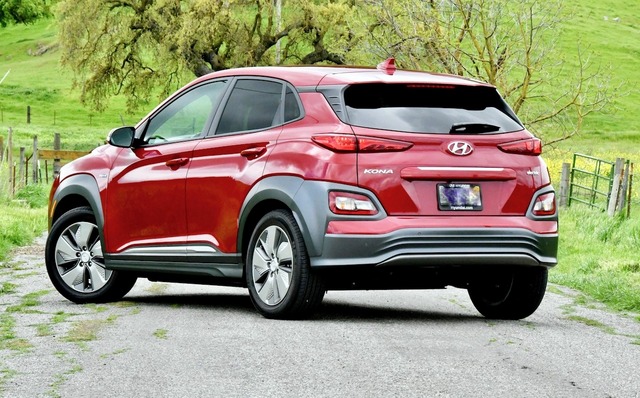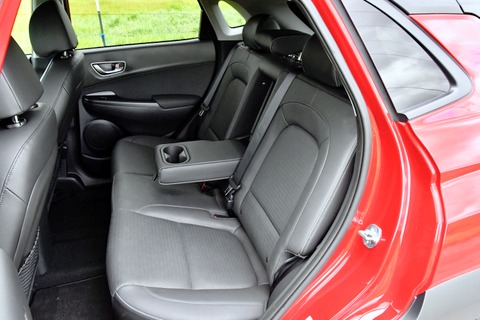Far-Ranging Compact Crossover EV
The world of electric vehicles (EVs) is expanding as more new models and versions of existing cars arrive. Enter the 2019 Hyundai Kona EV. The small crossover is the most direct competitor to the veteran Chevrolet Bolt EV. It’s almost the same size, and all its statistics are virtually identical. But its EPA range is a whopping 258 miles—20 more than the Bolt—and its styling is more crossover than hatchback.

My Pulse Red test car was the top-level Ultimate model—a step above the SEL and Limited. The Bolt EV offers two levels, but the price spread for entry vs. loaded is still about $7,000. That difference is mainly in comfort and convenience features, so all Kona EVs get the same 150 kilowatt electric motor with 201 horsepower and 290 lb.-ft. of torque, fed by a 64-kilowatt-hour lithium-ion polymer battery system.
Adding a sunroof, leather seating and wireless charging (and more) brings you to the Limited. When you include a larger 8.0-inch touchscreen, head-up display, ventilated front seats and smart cruise control, you’ve got the Ultimate. Visit Hyundai’s website for details.
Hyundai has become successful over the years by equipping its cars with plenty of standard features and improving the styling, materials and assembly quality. This Korean brand sits right at the top echelon of J.D. Power’s initial quality ratings.
A Different Face

The Kona EV wears a different face from its gas-drinking sibling. They covered up the unnecessary grille hole with a textured plastic panel. Funny that most electric cars still get “mouths” even if they don’t need them. Of course, the Nissan Leaf, having no non-electric version, never had one.
The interior feels contemporary and familiar, nice but not outright luxurious, even at the top level. As with other EVs, a lot of cost goes into the battery pack. But while some people have complained about the Bolt’s hard plastic interior, in the Kona things feel a little more cushioned.
Regeneration is important in any electrically-powered car. The Bolt lets you drive in “D,” which approximates a normal automatic transmission, or click into “L” and you get enough regeneration when you lift your right foot to literally come to a full stop at a traffic light without using the brake pedal. The Kona EV lets you choose from three levels of regen (or none), however the regen cuts out at a few miles per hour, necessitating the brake.

The tendency with an electric car is to drive gently to preserve battery charge. The Kona gives you a choice of Normal, Eco and Sport settings. Normal is balanced between the other two, and the instrument panel displays a speedometer with the charge level in the center. Eco makes some changes to help you keep it slow and steady and displays an Eco gauge to monitor your driving behavior (by selecting Eco you’re saying you’re interested). Sport takes more advantage of the motor’s torque and displays a power gauge instead. Driving mostly in Normal, I averaged 4.1 miles per kilowatt hour, which calculates to 262.4 miles—darned close to the advertised range.
Charge times are 9 hours, 35 minutes for Level 2 240-volt service, a couple of days on normal level 1 household current, or you can get an 80 percent charge on Level 3 DC fast charging in under an hour.
The Hyundai Kona EV’s EPA numbers are 132 MPGe city, 108 highway and 120 combined. Compare that to the Bolt, with 128/110/119 respectively. That’s about as close to identical as you can get. The Smog and Greenhouse Gas numbers are perfect 10s, of course.
Not Big, But Big Enough

The Kona is not a large car, and the rear seating can be a little tight, depending on where the front seats are set. For cargo, you’ll get 19.2 cubic feet with all seats up and 45.8 cubic feet when you drop the rears. That’s plenty for most of us.
Pricing is in line with the other nonluxury EVs, including the Bolt EV. The SEL starts at $36,950, Limited at $41,400, and Ultimate at $44,900. Add $1,045 for shipping. My tester came to $45,830 with carpeted floormats and a $44,650 starting price. Federal and state rebates and tax breaks apply, and the window sticker says, “You save $4,250 in fuel costs over five years compared to the average new vehicle.” Believe it. Zero on maintenance, too.
I expect the new Kona to be successful, with the right look for today and by including a few items the Bolt EV doesn’t, such as standard DC fast charging and available smart cruise control. It just won the 2019 North American Utility Vehicle of the Year award, so it’s off to a great start.
Related Stories You Might Enjoy—The Affordable EV Competition
Road Test: 2019 Kia Niro EV (Steve’s view)
Road Test: 2019 Kia Niro EV (John’s view)
Road Test: 2019 Chevrolet Bolt EV
Personal: Two Years with my Chevrolet Bolt EV
Road Trip: 2019 Nissan Leaf Plus
Road Test: 2019 Hyundai Ioniq EV
Then there’s the gas version, too—2018 Hyundai Kona AWD
Make sure to opt-in to the Clean Fleet Report newsletter (top right of page) to be notified of all new stories and vehicle reviews.
Disclosure:
Clean Fleet Report is loaned free test vehicles from automakers to evaluate, typically for a week at a time. Our road tests are based on this one-week drive of a new vehicle. Because of this we don’t address issues such as long-term reliability or total cost of ownership. In addition, we are often invited to manufacturer events highlighting new vehicles or technology. As part of these events we may be offered free transportation, lodging or meals. We do our best to present our unvarnished evaluations of vehicles and news irrespective of these inducements.
Our focus is on vehicles that offer the best fuel economy in their class, which leads us to emphasize electric cars, plug-in hybrids, hybrids and diesels. We also feature those efficient gas-powered vehicles that are among the top mpg vehicles in their class. In addition, we aim to offer reviews and news on advanced technology and the alternative fuel vehicle market. We welcome any feedback from vehicle owners and are dedicated to providing a forum for alternative viewpoints. Please let us know your views at publisher@cleanfleetreport.com.

3 thoughts on “Road Test: 2019 Hyundai Kona Electric”